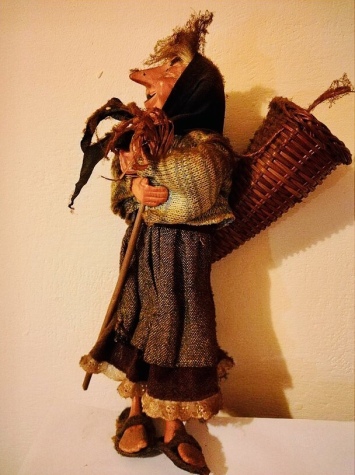Home
> Uncategorized > A New Year and the season for La Befana
A New Year and the season for La Befana
March 3, 2019
(This column was written shortly after the start of the year but some travel plans delayed its appearance here. D.B.)


This kindly looking La Befana is not quite as scary as some traditions would have you believe. Photo courtesy of Wikipedia Commons
MONTEPULCIANO, Italy – A midwinter calm has fallen on this ancient city deep in the heart of Tuscany. After nearly a month of holiday activities, culminating in the arrival of La Befana on Epiphany Eve (this year January 5), many of the businesses in the Centro Storico of Montepulciano have closed until spring because, like the swallows of Capistrano, the tourists mostly have gone elsewhere for the winter.
La Befana (say Beh-fá-na) is an ancient Italian custom (she first appeared in writing in 1549) although other countries have similar figures to mark the end of one year and the start of the next.
She most-often is portrayed as an old woman who spends the evening visiting children throughout Italy, leaving gifts of candy or coal according to the results of the “naughty or nice” scale.
Some pictures portray La Befana as riding a broom and wearing a black shawl covered with soot, picked up as she enters the house by dropping down the chimney.
Some families leave out a small glass of wine and some snacks for La Befana in her travels across the country.
Similarities with Santa Claus (or Babbo Natale, as he’s called) don’t end there and it’s safe to presume Clement Clarke Moore had prior knowledge of this and similar traditions prior to writing “A Visit from St. Nicholas” in 1823.
It’s said La Befana’s name comes from the Feast of Epiphany, customarily the first Sunday after January 1, marking the arrival of the three Magi at the manger, which accounts for the gift giving.
La Befana, like dear old Santa, has been pictured as variously kindly and gentle or a bit of a dominatrix, depending on your attitude toward a broom-wielding stranger entering your home unannounced and tossing around bits of candy and coal (it’s usually black sugar or perhaps licorice but you get the idea.)
Sometimes there is a festival and maybe a parade featuring someone dressed as La Befana (ideas differ wildly) and if you really want her to be ugly, make it a him, which isn’t uncommon.
A woman working in one of the many wine shops here said she grew up scared witless that La Befana actually might make a showing.
“The first time I saw someone dressed like her, and remember this was many years ago and I was just a child, there was this big man dressed up with a huge nose and wild hair and all in black and carrying a broom,” Roberta said with a laugh. “He approached me and I started crying and grabbed my mother and tried to run. I still don’t like it.”
The broom also is part of the legend. The “good” La Befana may sweep the floor before she leaves each house, which to many signifies the sweeping away of last year’s troubles.
Because of the long Christmas holiday, this town and many others enjoy a bit of a late-December boom as visitors crowd the shops and restaurants, meander lost along the narrow streets and generally do what wine-country tourists do, which is spend money.
“It was a good season,” one shopkeeper said as he removed the “Buona Festa” banner from his door. “But I’m tired after three weeks straight. I’m closed today.”
And he went inside and locked the door.
And thus another detto or saying: “l’Epifania tutte le feste porta via” (a very rough translation: “After Epiphany, all the holidays go away.”)
———————-
Categories: Uncategorized